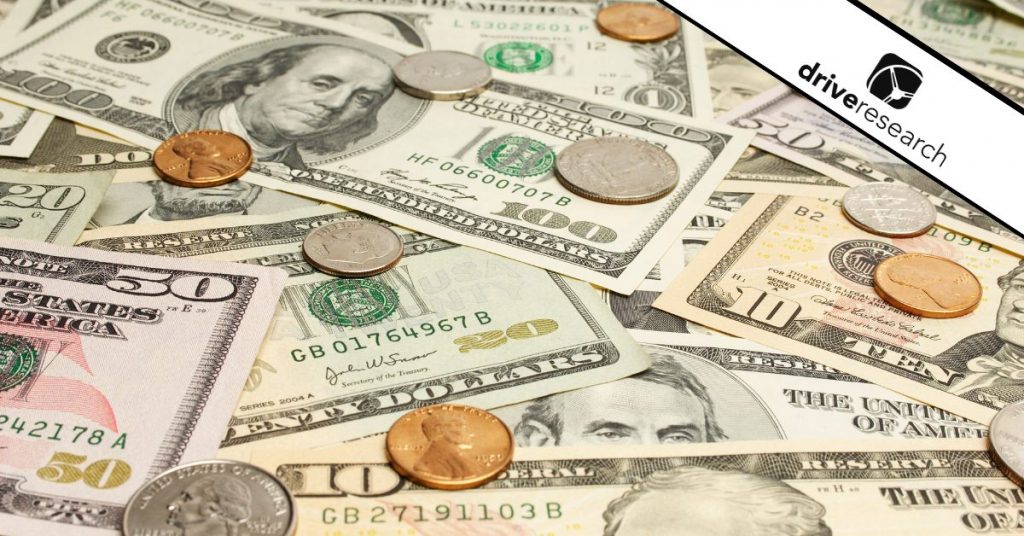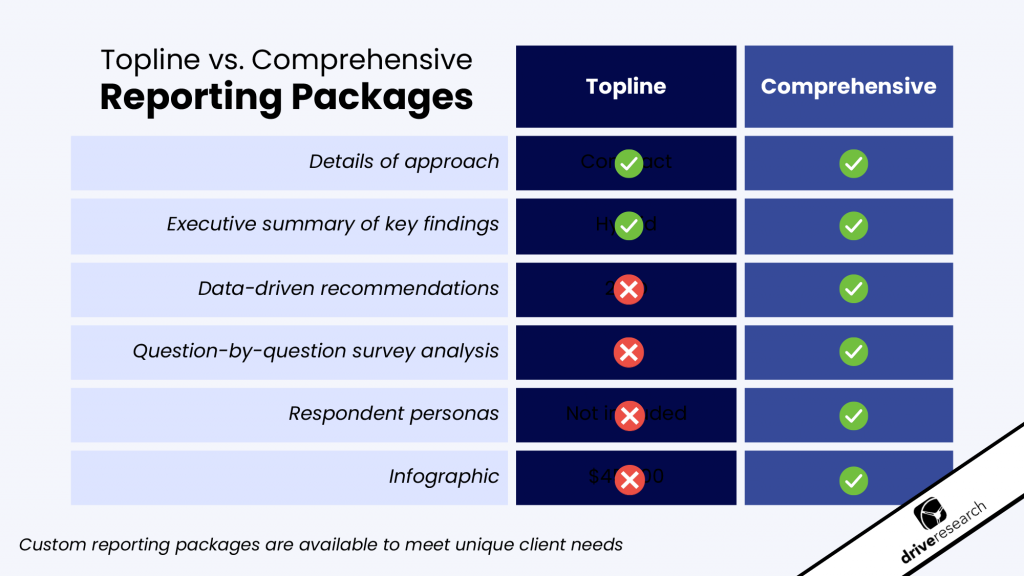
Wondering how much market research costs? The answer isn’t one-size-fits-all. Project pricing can vary widely depending on your target audience, research method, incentive strategy, and more. For instance, a basic online survey targeting the general population will cost significantly less than a focus group focused on a niche group like millennial women with red hair.
In this blog post, we’ll break down the key factors that influence market research pricing and compare the costs of different research approaches to help you budget with confidence.
How Much Market Research Costs (By Methodology)
The cost of market research varies significantly depending on the methodology you choose. While your goals and objectives will largely determine the right approach, your budget often plays a key role too.
To give you a starting point, we’ve outlined estimated costs by methodology below.
Keep in mind: these are ballpark ranges.
Actual pricing depends on factors like audience targeting, project complexity, incentive amounts, and more. The best way to get a precise quote? Reach out to a market research company directly.
| Market Research Method | Estimated Cost Range |
|---|---|
| Online Survey | $5,000 – $15,000+ |
| Phone Survey | $15,000 – $30,000+ |
| Mail Survey | $10,000 – $25,000+ |
| In-Person Survey | $20,000 – $50,000+ |
| In-Depth Interviews (IDIs) | $5,000 – $15,000 (10–15 interviews) |
| Focus Groups | $7,000 – $20,000+ per group |
Cost of Qualitative Market Research
Qualitative research typically costs more than quantitative because it involves one-on-one or small-group conversations—often with harder-to-reach audiences and higher participant incentives.
In-Depth Interviews (IDIs)
Estimated cost: $5,000 to $15,000 per 10-15 interviews
IDIs are often more affordable than focus groups and require less setup. Costs can be reduced by conducting interviews remotely (via phone or Zoom) and keeping them short (30 minutes or less).
Focus Groups
Estimated cost: $7,000 to $20,000+ per group
Focus group pricing depends on several factors, including:
- Number of groups
- Target audience difficulty
- Incentives (often $75–$150 per person)
- Add-ons like facility rental, live streaming, video recordings, and even catering
Tip: Online focus groups are a great way to lower costs while still gathering in-depth insights.
Cost of Quantitative Market Research
Quantitative research is generally more cost-effective because it collects structured data from a large number of respondents. The method you choose—online, phone, mail, or in-person—makes a big difference in pricing.
Online Surveys
Estimated cost: $5,000 to $15,000+ for 400 responses
This is the most budget-friendly option. Costs depend on survey length, target audience, and whether incentives are included. Most data is collected automatically, saving time and money.
Phone Surveys
Estimated cost: $15,000 to $30,000+ for 400 responses
These are more expensive because live agents are needed to conduct the calls. Costs increase with survey length and specialized targeting.
Mail Surveys
Estimated cost: $10,000 to $25,000+ for 400 responses
Mail surveys require printing, postage, return shipping, and manual data entry—making them more time-intensive and costly than online alternatives.
In-Person Surveys
Estimated cost: $20,000 to $50,000+ for 400 responses
This is typically the most expensive option due to staffing, travel, and logistics involved in intercepting respondents face-to-face.
There’s a methodology for every budget—especially with creative adaptations like online focus groups or short-form surveys. But if you’re unsure what option fits your goals and your budget, it’s always best to get a custom quote from a trusted research partner.
Get a quote from Drive Research
What impacts how much market research costs?
Well, there are several factors at play.
Again, while there’s no “average cost” because every project is unique, there are a few factors to consider thinking about if there are budget concerns for a market research project.
Type of market research you are conducting
There any many different types of market research. From online surveys to in-home usage tests, there is a solution that can help meet any business’s objectives.
However, with this variety comes various market research costs.
For example, an in-person focus group will likely cost more than an online focus group.
With a traditional focus group, brands have to factor in costs related to:
- Renting a focus group facility
- Recruiting from a smaller sample
- Travel
- Higher incentives
Whereas, online focus groups eliminate many of these added line items.
There are little to no costs associated with virtual meeting tools like Zoom to host the remote focus group.
It will take a qualitative recruiting company less time and resources to find participants because they can dial in from anywhere.
There is no travel needed.
This same time of scenario can be repeated for all methodologies when discussing market research costs.
For a highlight real of the most common types of market research, watch our video below.
The number of survey completes/groups/interviews
This refers to the actual number of fully completed surveys, focus groups, or in-depth interviews.
Fewer respondents/groups/interviews will be less expensive.
That’s because it will take less time and resources for a market research company to recruit participants, clean the data, and analyze the feedback.
However, keep in mind, with less comes an increased margin of error. In other words, receiving 25 survey completes does not offer high reliability of the results.
As a general rule of thumb, here are the approximate margin of error for several common levels of survey completions:
- 100 completed surveys: +/- ~10%
- 200 completed surveys: +/- ~ 7 to 8%
- 400 completed surveys: +/- ~4 to 5%
- 1,000 completed surveys: +/- 2 to 3%
The more data, the better.
Target audience
This is a big one. It can be easy to assume reaching a target audience is much easier than in reality.
There is a direct correlation between the size of the population that needs to be targeted and the price of that project.
The more complicated the target audience is, the more it will cost to reach that specific audience.
For example, you will see higher market research costs if you are surveying pediatricians in comparison to college students across the country.
Incidence rate (IR)
This is similar to the target audience. In market research, an incidence rate (IR) refers to the percentage of people who qualify to complete the research (survey, focus groups, IDIs).
For example, if a survey targets the general population and wants to reach females only, the IR would be 50%.
A lower incidence rate will result in higher market research costs because it will be more time and resource intensive to find this audience.
Length of interview (LOI)
This is another important factor that market research clients can easily overlook. It is critical that research uses participants’ time as efficiently as possible.
Changing from a short 20-question survey to a longer, 40-question survey increases survey dropout rates. As a result, this impacts the cost needed to reach more respondents.
The same can be said for common forms of qualitative research.
A market research study that asks participants to spend 3 hours at a focus group facility will require more recruitment hours than a one-hour online focus group.
Incentives
Incentives and rewards widely vary based on the type of research.
It’s a safe bet that honorariums for surveys are far less expensive than those for focus groups and in-depth interviews.
For example, the honorariums for conducting a focus group with the general public may range from $50 to $100.
In comparison, the cost of conducting a focus group with business professionals may range from $200 to $250.
On the contrary, incentives can also lower the cost of market research.
By providing higher rewards, more people will be interested in signing up. Therefore, the time and resources needed to recruit participants are reduced – and so is the scope.
Recommended Reading: Higher Rewards Can Equal Lower Market Research Costs
Type of reporting
When reviewing market research costs, you should understand what you’ll be receiving from your market research company on the back end.
Options may include:
- Highlights sent via email
- Abbreviated reports
- Comprehensive reports
- Presentation style reports
Many market research companies charge for an expensive resort, but will simply export the data into an excel template or automate tables sent to you in a PDF with no analysis.
Others may charge a fortune to have a team of 10 people run banners and review every cross-tab imaginable.
Not to say market research companies should not be scrubbing and analyzing the data extensively, but oftentimes time and money are wasted on running cross-tabs on irrelevant demographics.
Will your organization ever use or want to know how females in ZIP Code 13202 rate your customer service on Wednesdays?
When your organization is reviewing market research costs for your next project, make sure the reporting charge reflects your needs.

The best market research companies like Drive Research are able to strike a balance between an affordable yet informative report.
We can show you the details and cross-tabs on the data that matters, but they can also tweeze out the key highlights, themes, and recommendations from all of the data you receive.
To learn more, read our blog post Topline vs. Comprehensive Market Research Report.
Determining Your Research Budget
Before reaching out to a market research company, it’s a good idea to have a general sense of your available budget. Even a ballpark figure can help guide the research design and determine what methodology, sample size, and timeline are most realistic for your goals.
Here are a few tips to help you think through your budget:
- Start with your business objective. Are you looking to test a new concept, understand your customer experience, or measure brand awareness? Your objective will influence whether qualitative or quantitative research is the best fit—and how much it might cost.
- Consider your audience. Targeting the general population is typically less expensive than reaching niche or hard-to-reach groups (like physicians, B2B decision-makers, or high-income consumers).
- Think about sample size. The more responses you need, the more you’ll likely pay—especially for phone, mail, or in-person methodologies.
- Be flexible on extras. Live focus group streaming, printed materials, data dashboards, or multilingual surveys can all add to your total, but a research firm can work with you to prioritize what matters most.
Ultimately, the best way to align your goals with your budget is to talk with a market research company. They can offer options to scale your project up or down and find cost-effective ways to get the insights you need.
Recommended Reading: Should I Share My Budget with a Market Research Company?
Contact Drive Research for a Quote
The cost of market research is relative to a number of factors. Therefore, for a more accurate quote, it is best to contact a market research firm like Drive Research with your project details.
Our team offers end-to-end project management services from design, fieldwork, reporting, moderating, recruiting, and more.
Interested in conducting a market research project with Drive Research? Contact us today.



